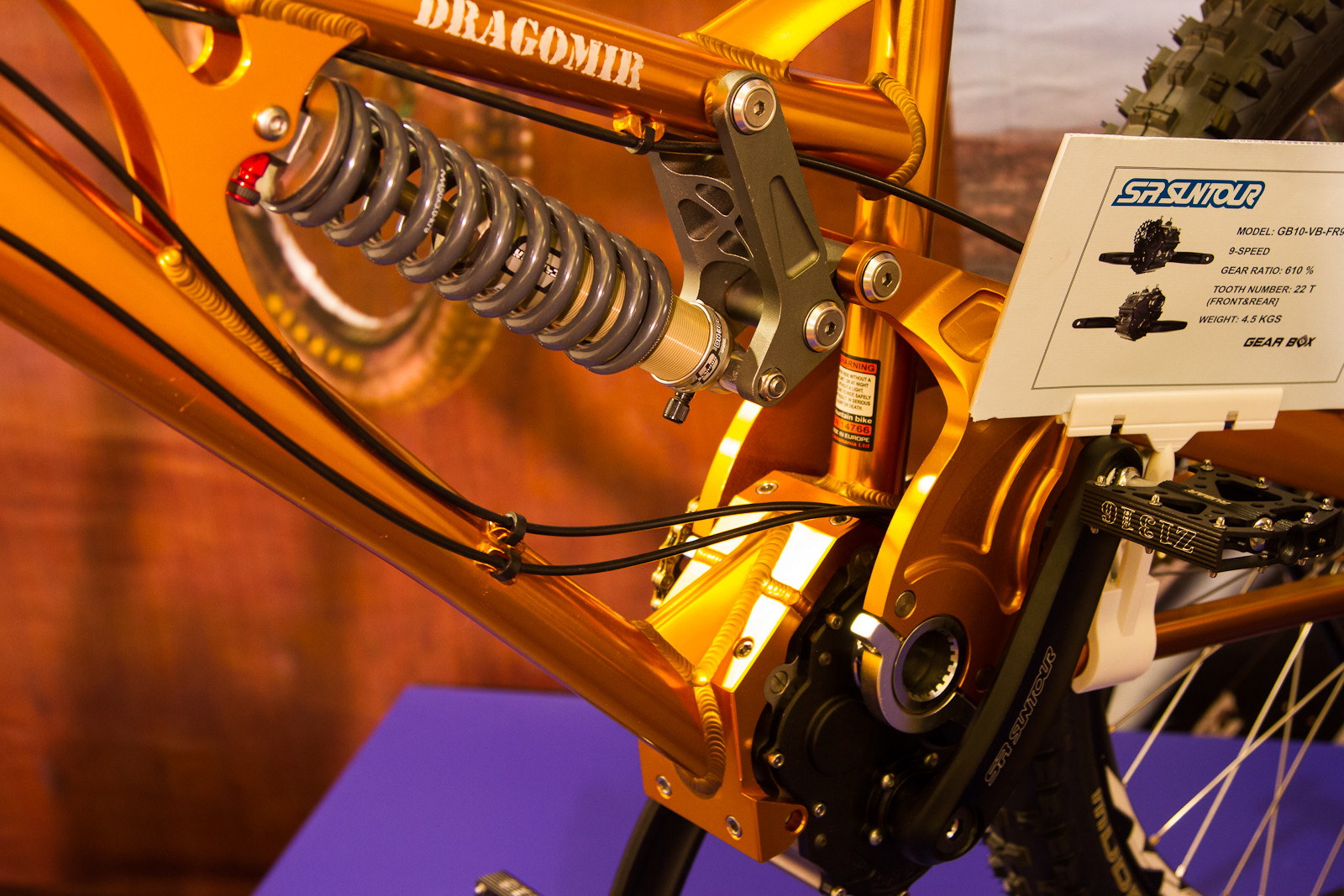Für V-Boxx-"Advanced Level"-Geeks:
Reparaturanleitung von
Dlogic.
Hi members,
just yesterday my Suntour V-Boxx broke down on me in the middle of a ride. When shifting down from the ninth to the eigth gear it just kept popping out. The same occured with gears number 3 and 6. A weird clicking noise could be heard when pedaling. Once home i decided to operate the thing. So after having put on my white doctors clothes things got nasty.
To say it right away i took the whole thing apart. To the last spring, screw, shifting cam, sprocket, washer, freewheel, etc. Nothing was left together in order to find out what whent wrong. This post will include loads of pictures and a detailed explanation of how this mechanical wonder works. If you ever have any problem with your box then don´t hesitate to write me a message. Why? Because i got the thing back together and it works better then ever before.
WARNING! You have a 2 year warranty on your V-Boxx. Doing what i did voids this immediatley.
Step 1
Remove the shifter housing by loosening the 3 screws that hold it in place. That´s the thing with the 2 shifting cables coming out of it. Now gentley pull it up and away. Now prior to opening the gear box clean the case with a mild cleanser and blast dry with compressed air. We don´t want to get any dirt inside!!
Step 2
On the same side where you´ve removed the shifting unit it´s now time to get rid of all the screws that hold the side plate in place. Around the crankshaft you´ll find a small round piece with a green rubber seal inside. This is held in place by 5 screws. Remove these and gently pull up.
Step 3
Now you´re ready to lift up the side plate. Don´t force it open using the screwdriver method. You´ll end up damaging the plates rubber seal.
Step 4
With one side gone, remove the aluminium housing between the two plates by simply pulling it up and away. Now unscrew the 4 aluminium control rods where the cams rotate over. CAUTION!!!! The 2 bearings on each control rod are located at different positions. You must mark which rod went where and of course the side of the plate they sit on.
Step 5
The Now turn the V-Boxx over to one side and use a rubber hammer to get the crankshaft out by gently giving a few taps on the hexagonal end still protruding from the other side plate. You´ll notice a black round aluminium piece will come loose. This sits on the hexagonal shaft and gives the green rubber seal a smooth round surface to run on. It has been pressed onto the hexagonal shaft, so that´s why you must use that hammer. Be gentle though, just remember that this is all clock work.
Step 6
Great Job! Now let´s take the middle gear shaft apart. Use a 5mm allen key to prevent the gear from turning and another 6mm one for loosening the aluminium top screw. Now you can pull of the big upper sprocket, the aluminium spacer and the sprocket below.
Step 7
It´s time to remove the output shaft. Grab yourself a 8mm allen key and get rid of the center screw that holds the piece in place where your chain sprocket is boltet onto with 4 screws.
Step 8
Now the output shaft can be removed. That´s it. You´re done!!
Step 9
Now the shafts can be dissasembled. You just pull of all the pieces and put them side by side. This is how the output shaft looks when stripped down.
Step 10
This is what broke down on my V-Boxx. The bearing inside the sprocket used for the 3,6 and 8 gear.
Step 11
Yeah, found it. The bad part though where the bits and pieces that fell inside the V-Boxx. That´s why i washed all the parts with a special cleaner and blastet them dry with compressed air. Now with everything clean the task of finding this thin ring bearing with flange was almost impossible.
These types fit: JNK F2027 VRS (That´s the original bearing)
F61704 2 RS (Alternative 1)
61808 2 RS (Alternative 2)
To make things worse when i finally found a company that had it in stock, they wanted 27  for it. Ouch. The only thing the flange is needed for is to prevent the sprocket from moving in axial direction. When the bearing failed this is what happened. The clutch snaped in and my V-Boxx whent bananas. So i did the following. By simply pressing a 2mm wide ring, i made on my lathe, into the sprocket i could use a standard bearing. The price was just 2,70 Â. Hey Suntour, why don´t you make the sprocket like this? Also these tiny bearings aren´t made to take big axial loads. Underneath this sprocket an axial bearing takes the load from the springs of the clutch below. But all this presses against the bearing with the flange that fell apart. Not good at all. In my opinion this leads to failure sooner or later. I rode the V-Boxx exactley 7842 km.
Step 12 (Reassembly and adjustment)
It´s time for the most difficult part. Start with the crankshaft and the middle gear shaft. These are placed through the bottom side plate. That´s the one opposite from where the shifter unit with the cables go. Use the crank to press the black aluminium spacer back onto the hexagonal shaft. You simply tighten the cranks screw and this automatically pushes the piece into place.
Step 13
The lower camshaft of the output shaft is next. I fixed the springs with some grease to prevent them from falling out. You then flip it over and place it onto the bearing still inside the side plate. Don´t forget the washers that should be placed between the bearing and the springs. Warning!!!! The thick washer is where the springs rest upon. The thin ones adjust the axial play between the bearing and the piece that will hold the chain sprocket later. If you place the springs on the thin washers then these will wear out rapidly. Since i modified the sprocket to use a normal bearing i had to grab myself these adjustment washers to control the axial play the shaft has. A simple method is that the hexagonal shaft must sit about 0,05 mm above the piece that holds the chain sprocket. If the shaft sits below then once you tighten the center screw, this will excert unnecesary pressure on the bearing causing the shaft to stop rotating with ease. You also adjust the height of the gears inside. You can move the whole shaft up and down like this. If you leave it up to high, then the shifting cams will not rotate smoothly. If it sits too low, then the clutches won´t open enough. They should open at least 1,3mm.


Step 14
Now that you´ve got all 3 shafts back in place it´ll get a bit tricky. It´s time to insert the 4 aluminium control rods. The ones you´ve removed in step 4. These feature 2 bearings on each piece and this is where the cams rotate over making the clutches close or open. Now to the complicated part. The 4 cams have a logic to them. Of course, they are responsible for the gearshifting to work. Fortunatley there is a final, or should i say start postion of these. The control rods bearings have to sit on that final part where the cam faces upwards. The bearings don´t go past this point. That´s what you have to do. Rotate the top and bottom cams to this position and bolt down the control rods. Look at the picture here. You can clearly see the end position of the cam. The cam is of black color and just touches the bearing.

This step has to be repeated for the crank and of course the output shaft. The other 2 control rods that are boltet down in the front part of the vboxx don´t have this final position.
They just work in parallel to the back control rods to help the shifter cam move up and down with less effort. Once you´ve got all for cams facing this way, it´s time to insert the main shifting shaft. That´s the piece with the 4 cogs with equal teeth. The final position of the shifting cams is very unstable. When inserting the shifting shaft you have to be very careful. If any of the cams move then the gears won´t shift correctly later. To be sure that you´ve inserted the shifting shaft the correct way you simply look at the rear part of the vboxx to check if all the cams are still at the final postion against the bearings of the control rods.
Step 15
The top of the shifter shaft features a square surface where the shifting unit will be boltet down with 3 screws. This is the worst part now. Turn the twist grip to the first gear and check out the position of the internal square of the shifting unit. This has to correspond with the postion of the square on your shifting shaft. Mount the top plate now leaving the 2 more or less aligned. You´ll probably notice that the milled out outer form for the shifter unit on the top plate will not fit it. Why? Because both have to be aligned perfectley. This is the bad thing about the Vboxx. The German Rohloff indexes the gears inside the hub. The Vboxx does both. The cams slide into position and the twist grip shifter also features positions that lock in. If the cams and the twist grip don´t lock into position both at the same time then your gears won´t be selected perfectley. On the first gear all 4 clutches are open. If you push your bike backwards and hear a clicking noise then this setup has not been done correctley. If seen a lot of Vboxx bikes where this was the case. This adjustment takes time. Once you´ve got it right the shifting unit is boltet down on the top plate with just 1 screw.
Step 16
You´re almost done. However this setup, without the housing is no good for riding around. We´re doing this so you can see what happens inside the box when you rotate the twist grip shifter. Look at the cams closeley now. On the first gear all the clutches have to be opened. Now switch to second gear. The lower clutch of the crankshaft should close now. When the twist grip clicks in to position then the clutch must be closed all the way. If not, or it starts to open just a bit then it´s time to adjust the lower shifting sprocket on the shifter shaft. With a 2,5 mm allen key you have to loosen the 3 screws that fix the sprocket to the shaft. You can then rotate the cam into position. This can be done with all 4 cams.
Step 17
Notice that i´ve colored the head of one screw with red paint. This is necessary so you know which to loosen last, since you have to rotate the shifter shaft around a bit to reach the 2 other screws. When you rotate back, you just loosen this red screw and turn the cam into position where the clutch closes all the way.
Step 18
Remove the top plate and then you will have to slide the aluminium case over the 4 control rods. Be careful that the shifting shaft doesen´t move. You can see that i´ve marked the tooth insert with white paint. It´s helpfull as long as the top plate is still missing to give an optical indication that everything is still in place. Now very,very carefully slide the top plate over the shafts and tighten the screws.
Step 19
Reinsert and bolt down the shorter screws that go into the control rods.
Presto, that´s it you´re ready to enjoy the Vboxx once again. There are still loads of details i haven´t written down here. This guide is only for the true enthusiast. A high level of skill and lots of patients are requiered for a succesful repair. So please don´t make me responsible if this doesen´t help you out. Mechanical knowledge is a must for this.
Cheers,
Dlogic ï
Last edited by Dlogic on Sat Nov 05, 2011 7:22 am, edited 4 times in total.




























